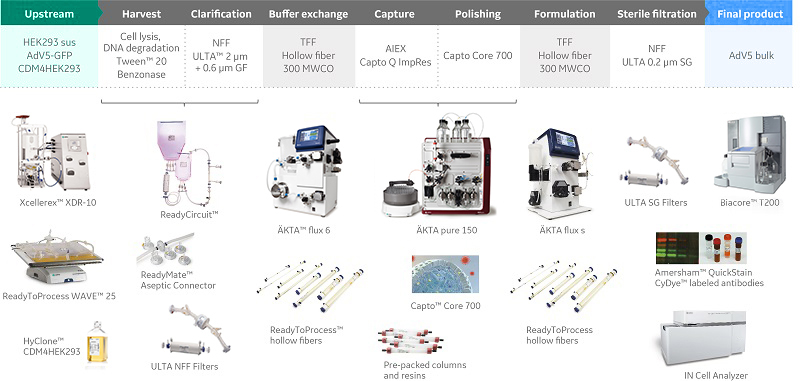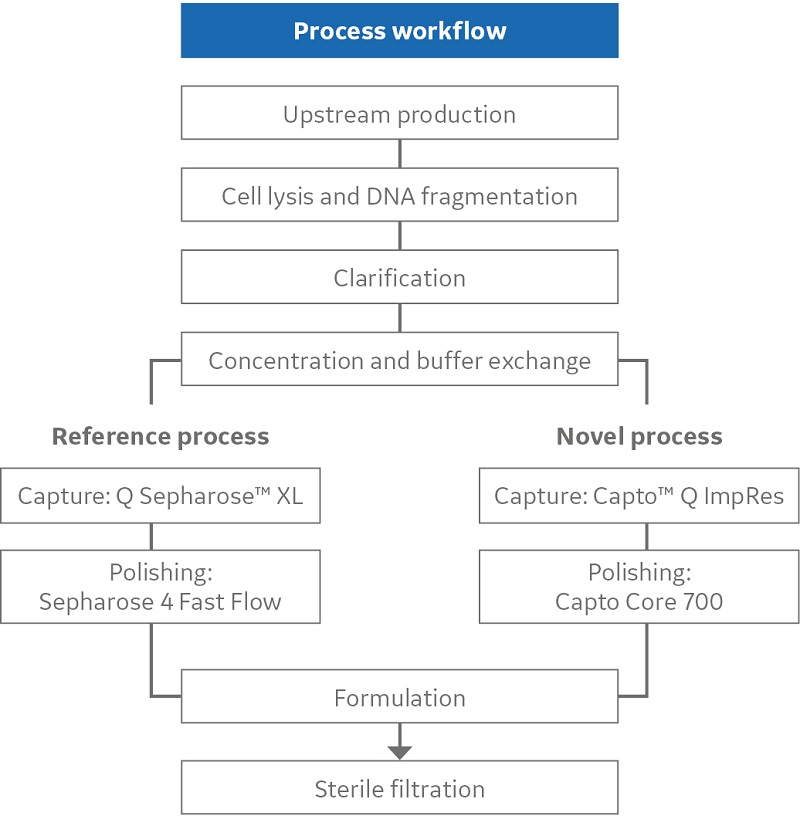What is a viral vector?
Viruses are infectious agents that can only replicate inside of living cells. This trait is used by molecular biologists for delivery of genetic materials into cells. Viral vectors are also explored for use in gene and cell therapy and as basis for prophylactic and therapeutic vaccines. In gene therapy, viral vectors can be used for delivery of functional genes to replace defective genes to cure genetic disorders. As a vaccine platform, viral vectors can be used for expression and presentation of pathogenic antigens to induce an immune response by mimicking a natural infection. Viral vectors can also be used in oncolytic therapies to specifically target and kill tumor cells.
Viral vector systems
Although tailored to their specific applications, viral vectors share some key attributes. Vectors should be modified to provide safe handling (no production of new virions in host) and low toxicity (no effect of the physiology of the normal host cell). They should also be stable (no rearrangement of genome), and for manufacturing, it is important that the viral vector is easily quantified and that it lends itself to large-scale production. Example of viral vector systems are retrovirus, lentivirus, poxvirus, adenovirus, and adeno-associated virus.
RETROVIRUS
Recombinant retroviruses have the ability to stably integrate into the host genome. These viruses express a reverse transcriptase to copy its RNA genome into DNA and an integrase to integrate the DNA copy into the genome of the host cell. Typically, replication-defective retroviruses are used in medicine, as these viruses can infect and deliver its viral genome, but fail to lyse and kill the host cell. Retroviruses, however, can only integrate into the genome of actively dividing cells. Hence, many cells (e.g., neurons) are resistant to retrovirus infection and integration.
LENTIVIRUS
Lentiviruses are a subclass of retroviruses, but in contrast to other retroviruses, lentiviruses can integrate into the genome of non-dividing cells. As retrovirus vectors, lentivirus vectors never include genes for replication. Lentivirus production therefore require propagation in, so called, packaging cell lines such as HEK293 cells transfected with plasmids that encode the virion proteins. Lentiviruses are commonly used for cell therapy.
POXVIRUS
The poxvirus family comprises numerous species, of which one is vaccinia virus (VACV). As it induces a strong immune response in humans, VACV is tested in recombinant vaccines as a vector for expression of foreign proteins. In wildtype form, VACV has also been successfully used to eradicate smallpox. VACV is a double-stranded DNA virus that enters its host cell by cell fusion. Its large genome (185 kilobases) tolerates insertions of foreign DNA fragments of more than 25 kilobases, creating an opportunity for use of VACV in vaccines with large or even several antigens. Poxviruses have also been modified and tested as oncolytic therapies.
ADENOVIRUS
Adenoviruses are double-stranded DNA viruses that replicate in the cell nucleus of vertebrates. In opposite to retroviruses and lentiviruses, adenoviruses do not integrate into the genome of the host cell. Adenoviruses allows foreign DNA to easily be introduced into their DNA, and they can be propagated in several cell types. In addition, adenoviruses have been shown to induce a broad immune response, including cytotoxic T cells. Hence, adenovirus is one of the most explored viral vectors for use in vaccines against infectious diseases and in oncolytic therapies. It has also been used in the development of therapeutic vaccines, and in gene therapies.
ADENO-ASSOCIATED VIRUS (AAV)
AAV is a single-stranded DNA virus that can infect both actively dividing and non-dividing cells of humans and some other primates. It can integrate into the genome of the host cell but mostly, as adenovirus, AAV replicate without incorporating its genome into the host cell chromosome. As opposed to adenovirus, which is a larger virus that can deliver DNA inserts of up to 36 kilobases, AAV is a small virus that can only deliver smaller inserts of up to 5 kilobases. AAV is mainly used for gene therapy.
Manufacturing of viral vectors
The promising results from clinical studies of the use of viral vectors to address important medical needs, have surged the interest in developing scalable and cost-efficient manufacturing processes. For gene therapy alone, the global market value is estimated to exceed 10 billion USD by 2025 (2). For regulatory compliance, products intended for therapeutic use should be well characterized and manufactured to high purity, efficacy, and safety, and high levels of GMP compliance should be met. The continuous development of recombinant viral vectors expands the commercial product pipeline, prompting the use of virus vector manufacturing platforms.
Process for scalable production of adenovirus
To meet market needs for scalable and cost-effective manufacturing of viral vector systems, scientists at Cytiva have developed a process for adenovirus production, from upstream cell culture to downstream purification, using modern tools and technologies. The developed process is easily scaled and compatible with both single-use and steamable hard-piped process equipment (Fig 1).

UPSTREAM PRODUCTION
Production of adenovirus was performed in HEK293 cells cultured in HyClone CDM4HEK293 culture medium. To demonstrate robustness of the upstream process, virus production was performed in both the rocking ReadyToProcess WAVE 25 and stirred-tank Xcellerex XDR-10 bioreactor systems. While ReadyToProcess WAVE 25 offers the possibility of shorter seed trains, as cell expansion can be performed in the bioreactor, XDR-10 provides the benefits of scalability, as part of the XDR bioreactor platform. The almost identical results obtained with the rocking and stirred-tank bioreactor systems not only demonstrate robustness of the process (Fig 2). The similarity in process outcomes also indicates the possibility of process transfer between the bioreactor formats. Both systems are all well-characterized, and data is available that may be used to facilitate process transfer between the systems.

Fig 2. (A) Cell growth, viability, and (B) adenovirus titer in 10 L HEK293 cell cultures conducted using the CDM4HEK293 medium in either the ReadyToProcess WAVE 25 rocking bioreactor system or the XDR-10 stirred-tank bioreactor system.
VIRUS RELEASE AND FILTRATION
A screening of detergents for HEK293 host cell lysis showed that treatment with 0.5% Tween™ 20 for a minimum of 2 h at 37°C under mixing is a good alternative to Triton™ X-100 that is on the authorization list (Annex XIV) of REACH. A liquid chromatography-mass spectrometry (LC-MS) method was used for determination of residual Tween 20. For removal of cell debris and initial impurity reduction, a combination of 2 μm and 0.6 μm GF filters were used. Ultrafiltration/ diafiltration (UF/DF) using a hollow fiber filter with NMWC of Mr 300 000 provide further reduction of impurities, while preparing the adenovirus-containing sample for subsequent downstream purification steps.
DETERMINATION OF VIRUS TITER
Two assays based on surface plasmon resonance (SPR) was used for determination of adenovirus concentration: one based on virus binding via the fiber protein to coxsackie adenovirus receptor (CAR) and one based on virus binding via the hexon protein to Factor X (FX). The novel analytical methods were used in parallel with established techniques for comparison and to ensure accurate monitoring of the processed material (Fig 3). The SPR assays were robust and provided reproducible results that correlated well with qPCR, while showing lower variation.

Fig 3. Comparison of virus titer determination using Biacore CAR assay, FX assay, or qPCR for samples from different steps of the adenovirus production process at 10 L scale.
DOWNSTREAM PURIFICATION
The downstream process was carefully optimized to meet stringent regulatory demands on product purity and quality. As adenovirus particles are negatively charged, an anion exchange resin is an attractive option for the capture step. However, DNA also binds strongly to anion exchangers, and was found to co‑elute with the adenovirus for most anion exchangers included in the resin screening. Eleven different anion exchange chromatography adsorbents were screened for the capture step. Of these, Capto Q ImpRes, exhibited the highest binding capacity for adenovirus. Capto Q ImpRes was also the only anion exchanger that provided enough DNA clearance in the capture step for Capto Core 700 to be a viable option for the polishing step.
While Capto Core 700 is not designed to remove full‑length DNA, giving size exclusion chromatography (SEC) a certain advantage, process economic calculations indicate that polishing with Capto Core 700 has advantages over the SEC approach, mainly due to the possibility of higher sample load volumes. Results from analyses of the final product show that the product met set criteria (Table 1).
Table 2. Results for final purified bulk fulfills criteria
| Overall recovery, IVP (%) IN Cell |
Overall recovery, TVP (%) qPCR |
TVP/IVP ratio Criteria: <30 |
gDNA ng per dose (1011 vp) Criteria: <10 ng |
HCP ng per dose (1011 vp) Criteria: <20 µg |
Residual Benzonase™ (ng/mL) |
Residual Tween 20 (%) |
|---|---|---|---|---|---|---|
| 45 | 34 | 25 | < LOD | < LOD | < LOD | ~ 0.0005 |
Results are average of three process runs. IVP = infectious virus particles, TVP= total virus particles, LOD = limit of detection. Disclaimer: analytical methods for IVP and TVP might have variation, which will affect the results for recovery and IVP/TVP ratio.
PROCESS ECONOMIC CONSIDERATIONS
Process economic considerations have accompanied the development work, and the novel adenovirus process has shown advantages over a reference process (Fig 4). A process economic simulation was performed using the BioSolve™ process economic simulation tool (BioPharm services), and costs per batch and per viral dose were compared between various combinations of process scale and titer. In comparison with the reference process, the described process was shown to be generally the most cost-efficient alternative. Process configurations using single-use equipment wherever possible were also generally more cost-efficient than corresponding configurations using primarily stainless-steel equipment (Fig 5).


Fig 5. Batch cost comparison across investigated titers and process scales for a single-product scenario, for stainless steel, single-use,and hybrid configurations.
Concluding remarks
The increasing interest in viral vectors and their promising use in applications for gene therapy and prophylactic or therapeutic vaccines also come with challenges. Sufficient manufacturing capacity is needed to meet market demands, expanding product pipelines require a platform approach to manufacturing, improved methods for purification and analysis are demanded to ensure well characterized products of high purity, efficacy, and safety.
Although adenovirus was the focus of the described adenovirus production process, this process could potentially be used for purification of other viral vectors. The novel process is scalable and compatible with both single-use as and steamable hard-piped process equipment. By omitting the need for cleaning-in-place, steaming-in-place operations, and associated validation procedures, single-use equipment allows more batches to be produced over a certain period of time, and changeover time between production batches or campaigns can be significantly reduced compared with using fixed stainless steel equipment. Single-use equipment also minimizes the cross-contamination risk between different production campaigns.
The results show that the novel process is a cost-efficient alternative for adenovirus production at all investigated scales and scenarios, making it feasible for industrial production of adenovirus, for example, for clinical applications, and the product was shown to meet regulatory requirements.
Read more about our vaccine platforms
Reference
1. Roots Analysis (Gene therapy market, 2015–2025 (2015).
- Application note: Evaluation of HEK293 cell growth and adenovirus productivity in HyClone CDM4HEK293 medium. GE Healthcare, 29264715, Edition AA (2017).
- Application note: Adenovirus production in single-use Xcellerex XDR-10 bioreactor system. GE Healthcare, KA874021017AN (2017).
- Application note: Adenovirus production in single-use ReadyToProcess WAVE 25 bioreactor system. GE Healthcare, KA879160418AN (2018).
- Application note: Optimization of midstream cell lysis and virus filtration steps in an adenovirus purification process. GE Healthcare, KA875220218AN (2018).
- Application note: Downstream process development for efficient purification of adenovirus. GE Healthcare, KA876080618AN (2018).
- Application note: Determination of adenovirus concentration using Biacore T200. GE Healthcare, KA878080618AN (2018).
- Application note: Scalable process for adenovirus production. GE Healthcare, KA877080618AN (2018).
- Application note: Process for production of oncolytic adenovirus_KA3940170818AN.